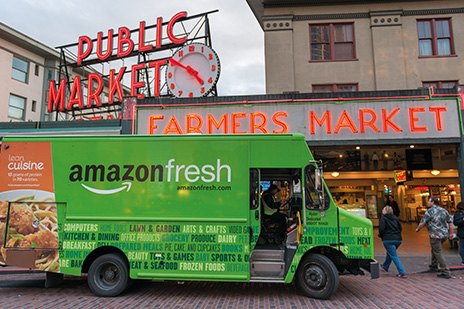Digital technology is set to change almost every facet of the moving business. Siddharth Mohan, CEO and co-founder of Yembo, and Mark Olsen, President and CEO of Parsifal Corporation, give their views of some of the most far-reaching developments ahead
What is digital transformation? By Siddharth Mohan, CEO and co-founder of Yembo
Companies around the globe are embracing digital transformation, suggesting that it is the holy grail to future competitiveness. Digital transformation can be simply defined as the use of digital technologies to solve business problems. In reality, it is so much more than this. It is the gateway to transforming business opportunities, operational hurdles, employee satisfaction, and the customer experience.
How is this possible?
Digital technologies have become pervasive. Anyone with a smartphone has access to a high-resolution video camera, 4G wireless speeds, ubiquitous Wi-Fi networks, high-speed processors, voice, text, and myriad applications – all put to use throughout the day, every day.
What really tips the scale in favour of businesses adopting digital transformation are new technologies that have matured and are now scalable for commercial applications, including hybrid cloud computing, cloud storage, artificial intelligence/machine learning, and computer vision.
Is this a fad?
Digital transformation technologies are being adopted by enterprise technology companies to
spur tremendous gains in business productivity
and competitiveness.
Innovative solutions for rethinking the customer experience, enabling remote workforces, implementing predictive modelling and maintenance, driving recommendation engines, and connecting with prospects and customers are making it easier than ever for businesses of all sizes – and in all industries – to make substantial and lasting changes. Better, faster, cheaper.

Goals include: removing barriers created by legacy business systems; reducing operational inefficiency; improving the customer experience; bolstering cybersecurity; and introducing new products or services to meet the expectations of an increasingly digital-savvy population.
According to a BDO US study published in January 2019, 71 per cent of companies pursuing digital transformation have reported increases in revenue, and 74 per cent have enjoyed increases in profitability.
What is the impact on the moving and relocation industry?
Consumers have embraced digital transformation. Smartphones and ubiquitous connectivity have changed the way customers want to do business. Amazon Prime has transformed the way we think about how we buy everything from books and clothes to cleaning products. Most things are delivered in a day, and the entire process is transparent – from order to delivery.
There is no doubt that the expectations set for delivery of toothpaste and dog food translate into consumers’ expected experience for their household goods move. The problem is that, because of technological limitations and costs, transforming the customer experience in moving has not been possible – until now.
The moving industry has been – and largely
still is – dominated by analogue processes characterised by: days (or weeks) for estimator visits; limited software support capabilities; a lack of transparency because of manual, paper-based records; and shortcomings in meeting growing customer expectations.
It is no surprise that a 2019 survey of 2,000 Americans found that one in five (23 per cent) believe moving is more stressful than planning a wedding; 27 per cent thought it more stressful than a job interview – and 13 per cent even went so far as to say it is more stressful than a week in jail!
When presented with the option to choose a moving and relocation company that embraces the benefits, transparency and expectations of their most cherished new pastime – online shopping – a huge opportunity emerges for moving companies willing and eager to go after digital transformation.
What are some examples?
At Yembo, we use artificial intelligence (AI), computer vision and new business process technologies to meet the increasing expectations of the customer – modernising the user experience for moving and relocation, and creating a convenient, transparent, trusted opportunity for winning more customers while gaining greater customer satisfaction.

Let’s take a critical part of customer experience in the moving industry – the pre-move survey. An accurate pre-move survey is needed for many things, including pricing, planning and executing a move efficiently.
To do a pre-move survey today, an onsite appointment needs to be scheduled days or weeks in advance. The shipper needs to stay home from work, and it typically takes an hour or more to complete the walkthrough process with a trained estimator. If the shipper’s needs change after the survey is completed, there is no easy way for them to communicate this effectively to the moving company. Moreover, there are no visuals to prepare the move-day crew for what to expect, which affects the quality of the move and the customer’s experience.
So we asked ourselves: ‘What if we could simultaneously improve the shipper’s experience, inventory accuracy, and the overall move quality, while reducing operating costs?’ After three years in the making, our team at Yembo accomplished this, allowing the shipper to participate in the move process by using their smartphone, alongside a smart AI engine and visual inventory management system.
With Yembo, our advanced computer vision and AI technology watches the video, provides you with the inventory list, and automatically creates snapshots from the video to let you know what the shipper intends to move. If a shipper’s inventory changes, this isn’t a problem – there is a secure text-message service to communicate the changes, and a move coordinator is notified to reflect that in the system inventory.
Likewise, a move coordinator doesn’t have to make a phone call for every question they may have after the survey. They can communicate their questions over the text-message service, and all communications are captured and recorded to ensure the move is smooth.
After completing more than 13,000 surveys in 2019, we’ve found that this interactivity is key to having an accurate inventory on move day. Our customers are also reporting a 50 per cent improvement in productivity using automation created by our AI.
The pre-move survey is just one aspect of how we can improve customer satisfaction and productivity. The output of the survey is tied to the driver’s inventory, so the move-day crew can prepare for move-day execution efficiently – and they use Yembo to indicate items loaded onto the truck, and record any damage requiring claims resolution.
The system is designed to give insight and visibility to every aspect of each move, enabling real-time data transformation to improve operations end to end, run more profitably, improve quality, and increase employee and customer satisfaction.
What does this mean for the moving and relocation industry?
Consumers will seek out technologies that make their lives simpler – that provide transparency, quality service and rapid feedback. Moving and relocation companies can embrace new technologies that reignite their brand, services and customer relationships.
These digital transformation services are globally available today to meet the growing demands of moving and relocation customers, and of companies that are ready to gain the strategic business and operational advantages of such solutions.

Relocation technology: looking to the past to create an answer for the future. By Mark Olsen, President and CEO of Parsifal Corporation
Technology has created some exciting solutions for the procurement of global removal services over the past few years, but it is still a long time since there have been significant changes to the traditional RFP/RFI approach – not to mention the billing and audit processes.
From where we sit at Parsifal Corporation, two major industry challenges today are the time involved in the RFP/RFI process, and the time involved in invoice creation, audit and payment. These are areas with tremendous opportunities for improvement through sophisticated procurement technology, as well as simplified invoice creation, audit and payment.
The traditional processes
The RFP/RFI process is long and laborious, involving extensive documentation with complex spreadsheets and, often, procurement personnel who are not familiar with the household goods/removal business.
The result is that the supplier spends a lot of time collecting and assembling rates, and the client spends a lot of time analysing and attempting to make sense of a significant amount of data that often only covers a percentage of their shipments.
On the auditing side, the process commonly doesn’t start until the move has been completed and the supplier invoice has been received. However, errors in this post-move audit are more difficult to resolve, creating pain for suppliers and delays in the invoice processing.

The future
Clearly, the primary goal of RFP/RFI is to ensure competitive pricing – hopefully without losing sight of the quality of service. At the same time, the intent of the audit (at least for Parsifal) is to bring unbiased accuracy to the billing process for removal invoices, and to do so with respect and fairness to all players.
Can these goals be accomplished while improving the process from the RFP/RFI to billing and payment? With the significant advances in blockchain, AI and data mining, the short answer is yes.
It starts with the technology to change the RFP/RFI from a single event every few years to an ongoing, technology-driven RFP that analyses price and service quality constantly. This involves system integration, from the virtual survey to pricing, plus an upstream audit of the move process as it occurs. It will mean an end to additional services or weight/volume of a shipment being challenged after a move; any issues will be resolved in real time. This will require the convergence of a few technologies and necessitate the resolution of initial challenges involving service fees that are tough to capture and support. We are, however, working with suppliers to surmount these hurdles.
From a handheld device, new technology can now perform the survey and will soon enable the supplier’s personnel to upload information for invoicing, auditing and payment at origin and delivery completion. This would have been unbelievable 10 years ago. Welcome to the future.

